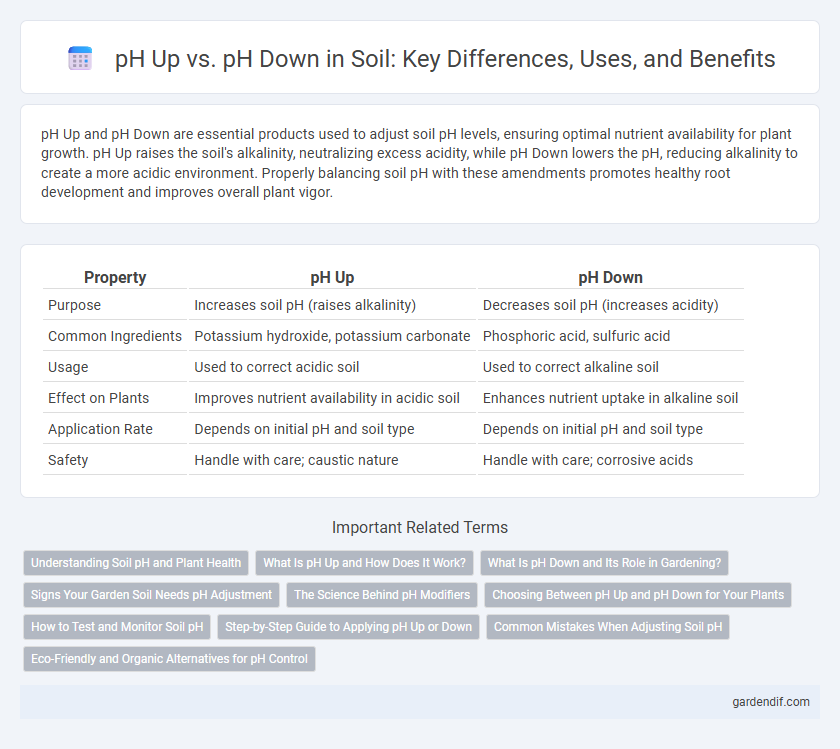
pH Up vs pH Down Illustration
pH Up and pH Down are essential products used to adjust soil pH levels, ensuring optimal nutrient availability for plant growth. pH Up raises the soil's alkalinity, neutralizing excess acidity, while pH Down lowers the pH, reducing alkalinity to create a more acidic environment. Properly balancing soil pH with these amendments promotes healthy root development and improves overall plant vigor.
Table of Comparison
| Property | pH Up | pH Down |
|---|---|---|
| Purpose | Increases soil pH (raises alkalinity) | Decreases soil pH (increases acidity) |
| Common Ingredients | Potassium hydroxide, potassium carbonate | Phosphoric acid, sulfuric acid |
| Usage | Used to correct acidic soil | Used to correct alkaline soil |
| Effect on Plants | Improves nutrient availability in acidic soil | Enhances nutrient uptake in alkaline soil |
| Application Rate | Depends on initial pH and soil type | Depends on initial pH and soil type |
| Safety | Handle with care; caustic nature | Handle with care; corrosive acids |
Understanding Soil pH and Plant Health
Soil pH plays a crucial role in nutrient availability and overall plant health, with pH Up increasing alkalinity and pH Down lowering acidity to maintain optimal growing conditions. Plants thrive best in a balanced pH range of 6.0 to 7.0, where essential nutrients like nitrogen, phosphorus, and potassium become most accessible. Adjusting soil pH using pH Up or pH Down products helps prevent nutrient lockout and supports robust root development and crop yields.
What Is pH Up and How Does It Work?
pH Up is a solution commonly used to raise the pH levels of soil or water by neutralizing acidity, typically containing alkaline substances like potassium hydroxide or sodium bicarbonate. It works by increasing the concentration of hydroxide ions (OH-) in the soil, which balances the pH toward a more neutral or basic range essential for nutrient availability in plants. Maintaining proper soil pH with pH Up helps optimize nutrient absorption, enhancing plant growth and overall soil health.
What Is pH Down and Its Role in Gardening?
pH Down is a solution typically composed of acids such as phosphoric acid or citric acid, used to lower the pH level of soil or hydroponic nutrient solutions. Maintaining an optimal soil pH using pH Down ensures nutrient availability by preventing nutrient lockout, which is essential for healthy plant growth. Gardeners rely on pH Down to correct alkaline soils, promoting efficient absorption of key nutrients like iron, zinc, and manganese.
Signs Your Garden Soil Needs pH Adjustment
Yellowing leaves, stunted growth, and poor flowering are common signs your garden soil needs pH adjustment. Soil pH outside the optimal range of 6.0 to 7.0 can limit nutrient availability, causing visible stress in plants. Testing soil pH regularly ensures timely application of pH Up or pH Down products to maintain healthy soil chemistry.
The Science Behind pH Modifiers
pH Up and pH Down are chemical solutions used to adjust soil pH for optimal nutrient availability and microbial activity. pH Up typically contains alkaline compounds like potassium hydroxide or potassium carbonate, which increase soil pH by neutralizing hydrogen ions. Conversely, pH Down often includes acidic substances such as phosphoric acid or sulfuric acid, which lower pH by releasing hydrogen ions to balance alkaline soils.
Choosing Between pH Up and pH Down for Your Plants
Selecting between pH Up and pH Down depends on the current soil pH and the specific plant requirements, as most plants thrive in a pH range of 6.0 to 7.0. pH Up, typically containing potassium hydroxide or potassium carbonate, is used to raise acidic soil pH, improving nutrient availability for plants sensitive to low pH levels. Conversely, pH Down, often made from phosphoric acid or sulfuric acid, lowers alkaline soil pH, enhancing nutrient uptake in plants struggling with high soil alkalinity.
How to Test and Monitor Soil pH
Testing and monitoring soil pH involves using a reliable soil pH meter or pH test kit to accurately measure the acidity or alkalinity levels. Regularly testing soil before applying pH Up (alkaline amendments such as lime) or pH Down (acidic amendments like sulfur) ensures optimal nutrient availability for plants. Maintaining a balanced soil pH between 6.0 and 7.0 promotes healthy microbial activity and nutrient absorption.
Step-by-Step Guide to Applying pH Up or Down
Adjust soil pH by first testing the soil using a reliable pH meter or test kit to determine if adjustment is necessary. Apply pH Up, typically potassium hydroxide or potassium carbonate, in small increments to raise soil pH, ensuring even distribution and thorough mixing into the topsoil layer. To lower pH, incorporate pH Down products such as elemental sulfur or aluminum sulfate gradually, monitoring changes over 1-2 weeks before repeating the process to avoid overcorrection and maintain optimal soil acidity for plant health.
Common Mistakes When Adjusting Soil pH
Using pH Up or pH Down without measuring the soil pH accurately leads to overcorrection, harming plant nutrient uptake and microbial activity. Applying these amendments too frequently disrupts the natural buffering capacity of the soil, causing unstable pH fluctuations. Ignoring soil texture and organic matter content when adjusting pH results in ineffective treatment and potential nutrient imbalances.
Eco-Friendly and Organic Alternatives for pH Control
Eco-friendly and organic alternatives for pH control in soil include natural substances like crushed eggshells, lime, and sulfur, which effectively raise or lower soil pH without harmful chemicals. Using compost and organic matter improves soil buffering capacity, maintaining stable pH levels while promoting microbial health. These sustainable methods reduce environmental impact and support long-term soil fertility compared to synthetic pH Up and pH Down products.
pH Up vs pH Down Infographic

 gardendif.com
gardendif.com